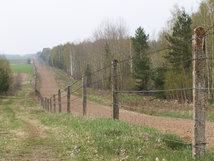Border: Belarus-Poland
Date(s) of establishment: 1945 (current demarcation), official existence in 1991Length of border: 418 km
Regions concerned: Poland – Podlaskie, Lublin
Belarus – Brest, Hrodna
European programme(s):
- Cross-border Cooperation Programme "Poland-Belarus-Ukraine" [European Neighbourhood and Partnership Instrument – ENPI]
Website of the programme - Baltic Sea Region Programme 2007-2013 [transnational cooperation]
Website of the programme
The programme on the Inforegio website
At a length of 418 km, the border begins in the south, at the tripoint formed with the Belarus-Ukraine and Poland-Ukraine borders. The river Bug forms the first third of the border, which is similar to the Curzon Line. It ends in the north, with the intersection of the borders of Lithuania, Poland and Belarus, and also marks the eastern boundary of the European Union.
History
Belarus experienced a brief period of independence between 1918 and 1920, becoming the Belarusian People’s Republic. It came to an end with the signing of the Peace of Riga (18 March 1921) which marked the end of the war between Soviet Russia and Poland. These two states subsequently divided Belarus between them, with the Soviet portion becoming the Belorussian Soviet Socialist Republic. A border separated this state from Poland until 1939.
Following the Second World War, the Yalta Conference established the border between Poland and the USSR that closely resembled the Curzon Line (proposed in 1919-1920). It was only in 1991, with the independence of Belarus in relation to the USSR that the border between the Republic of Poland and the Republic of Belarus officially came into being. The border has not been modified since.
This border became an external border of the European Union in 2004, and an external border of the Schengen Area in 2007. It comprises 13 border crossing points (7 by road, 5 by rail and one river crossing).
Cross-border cooperation
The border between Poland and Belarus is an external border of the European Union, therefore cross-border cooperation between the two countries progresses at a measured pace.
The cross-border cooperation programme that brings together Poland, Belarus and Ukraine was initiated by the ENPI (European Neighbourhood and Partnership Instrument). The main objectives of this programme are to improve quality of life, develop the competitiveness of the region, and to encourage the creation of networks and foster cross-border exchanges between the populations.
With regards to competitiveness, the measures are focused on entrepreneurship, tourism and accessibility. With Belarus and Ukraine being outside of the European Union, improving the efficiency of border infrastructure and procedures and border security forms one strand of the approach to improving quality of life. The programme also manages the implementation of a number of projects including the creation of a cross-border cycle path and the development of cooperation between emergency services, and joint risk prevention systems.
The border between these two coutnries does not benegit from a dedicated Interreg programme, but both countries participate in the “Baltic Sea” operational programme, (despite Belarus being landlocked). This programme aims to mobilise the Baltic Sea region in order encourage investments and multilateral collaboration between European neighbours. Several priorities have been set, notably focused around innovation and the improvement of accessibility in order to encourage cross-border cooperation and exchanges.
More specifically, cross-border cooperation between Poland and Belarus has focused on transport, and notably rail transport. While the two countries do not use the same track gauge for their railways, work has been undertaken on the line from Brest (BY) so that it is entirely electrified and can be used by all long-distance trains circulating between the EU, Poland, Belarus and Russia.
In other fields the situation is more complex, notably concerning Polish minorities living in Belarus.
Some Euroregions have been established and ensure tangible cooperation at a local level. For example, the “Bug” Euroregion, created in 1995, brings together three large towns, Brest (BY), Lublin (PL) and Lutsk (UA) and has a dedicated micro-project fund which has proved very useful in the region.


